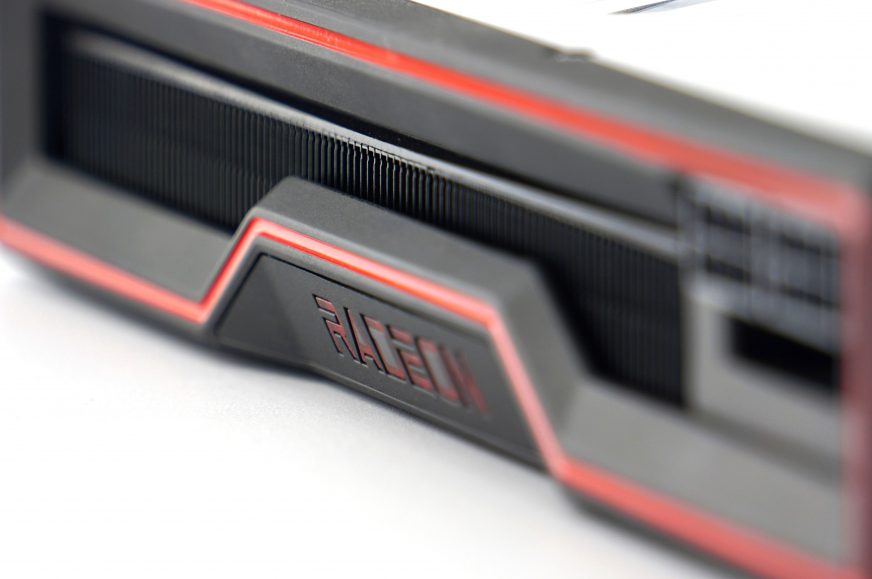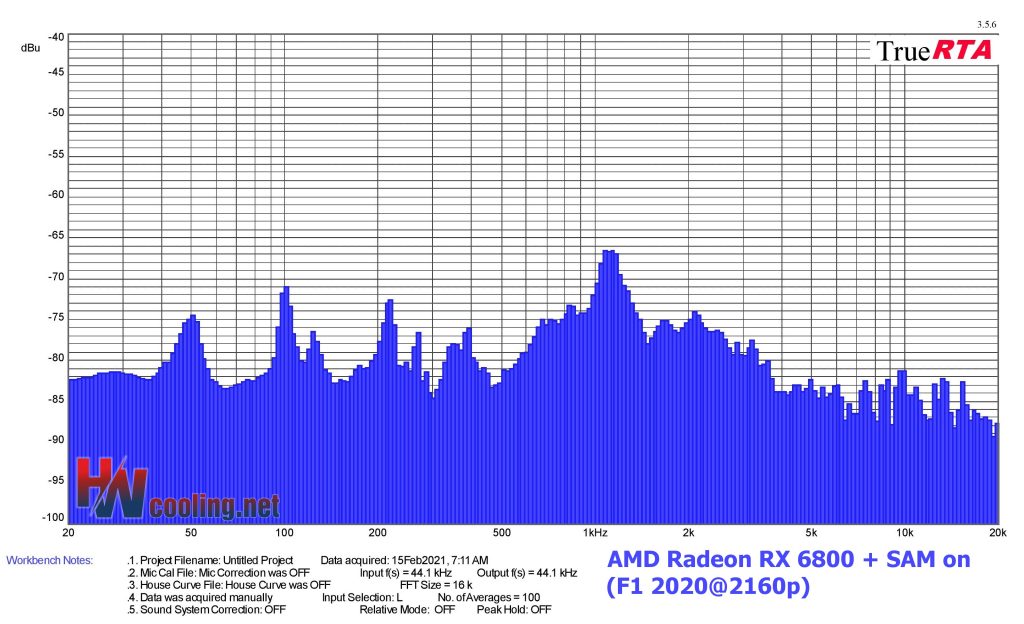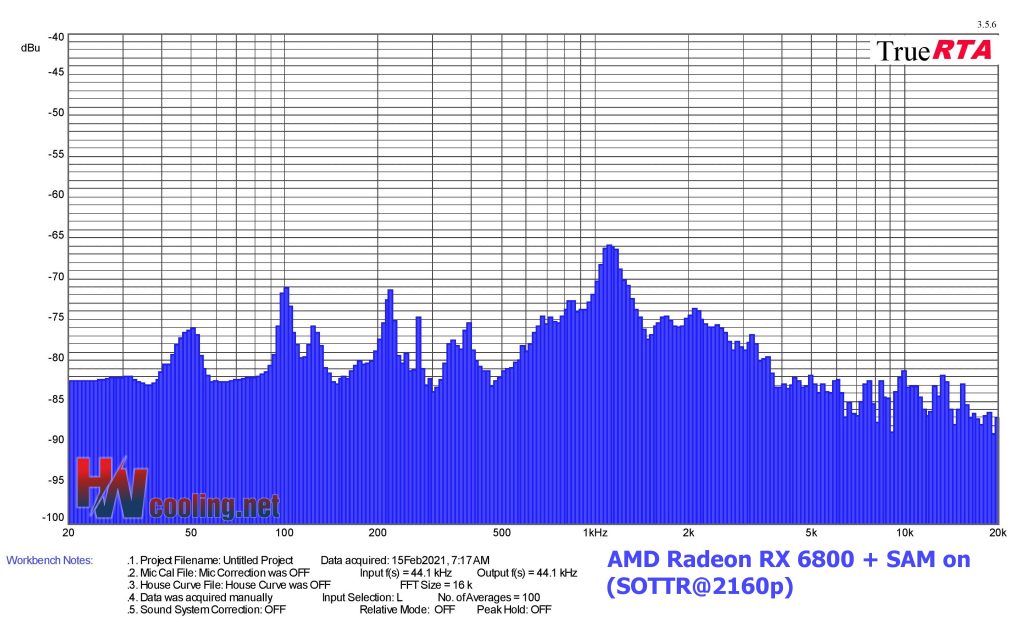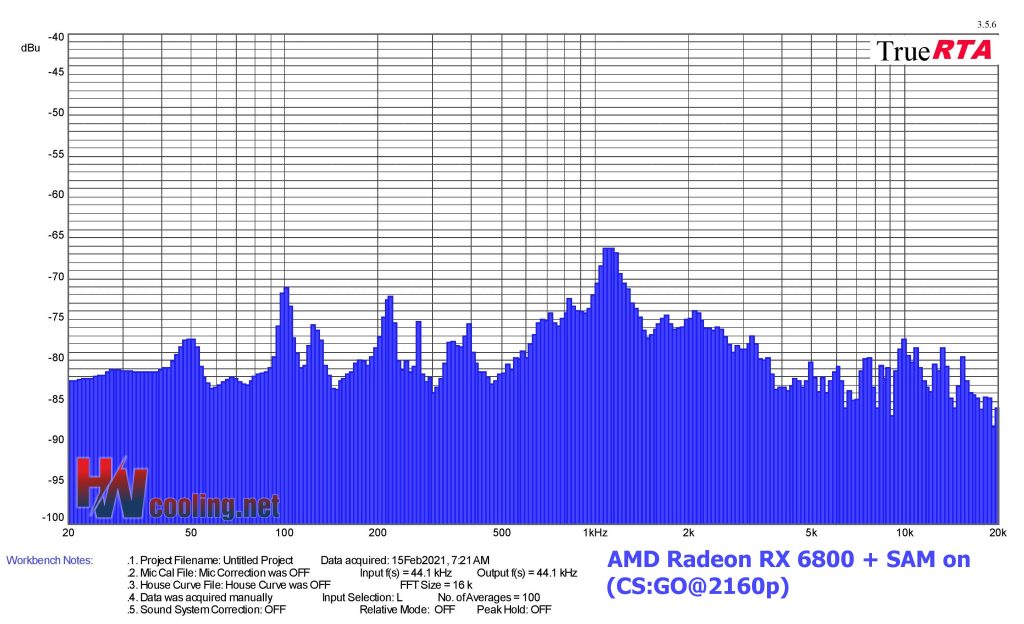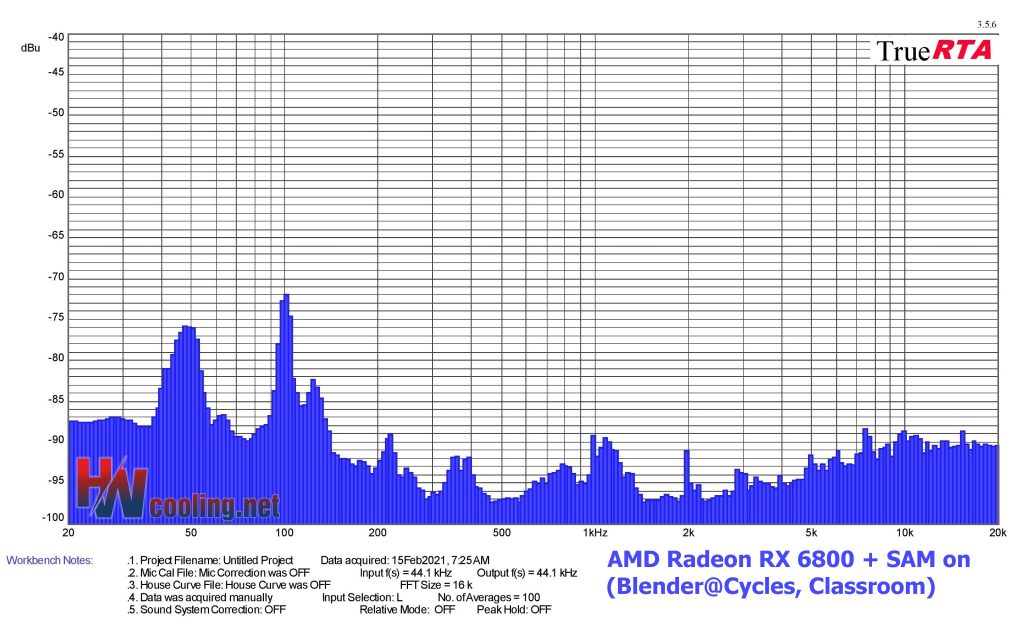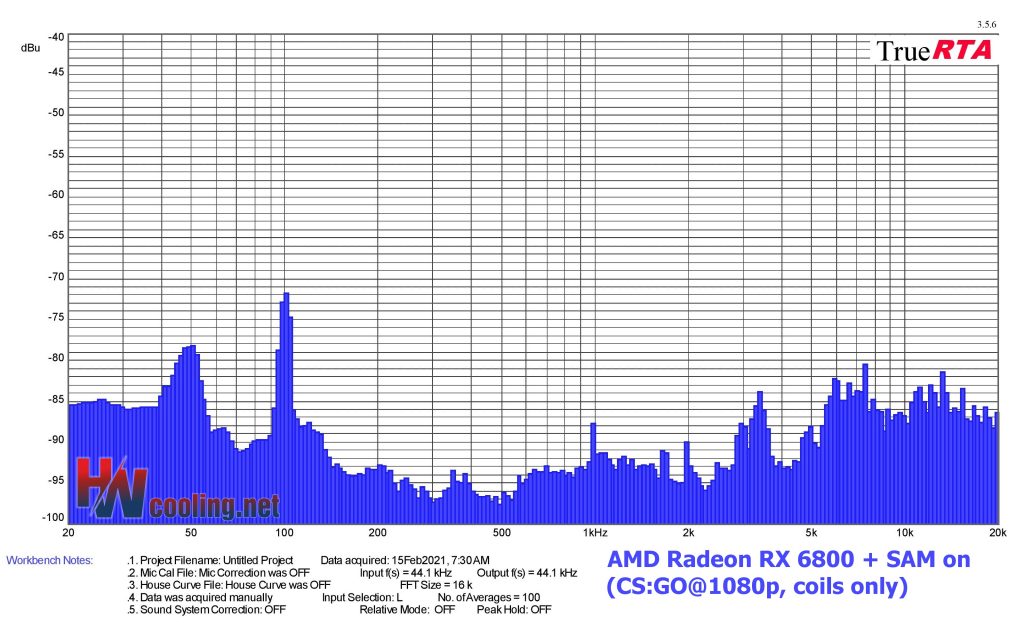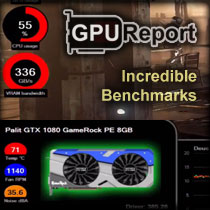Frequency response of sound
The Smart Access Memory feature is far from perfect. And although it is a useful technology overall, it also proves to be very unstable. What was true today may not tomorrow, and an in-depth analysis shows all those patches. On the one hand, those that eliminate the biggest problems that no one boasts about, and on the other hand, those that raise average performance in small steps.
Frequency response of sound
Measurements are performed in the TrueRTA application, which records sound in a range of 240 frequencies in the recorded range of 20–20,000 Hz. For the possibility of comparison across articles, we export the dominant frequency from the low (20–200 Hz), medium (201–2,000 Hz) and high (2,001–20,000 Hz) range to standard bar graphs. However, for an even more detailed analysis of the sound expression, it is important to perceive the overall shape of the graph and the intensity of all frequencies/tones. If you don’t understand something in the graphs and tables below, you will find the answers to all the questions in this article. That explains how to read the measured data below correctly.
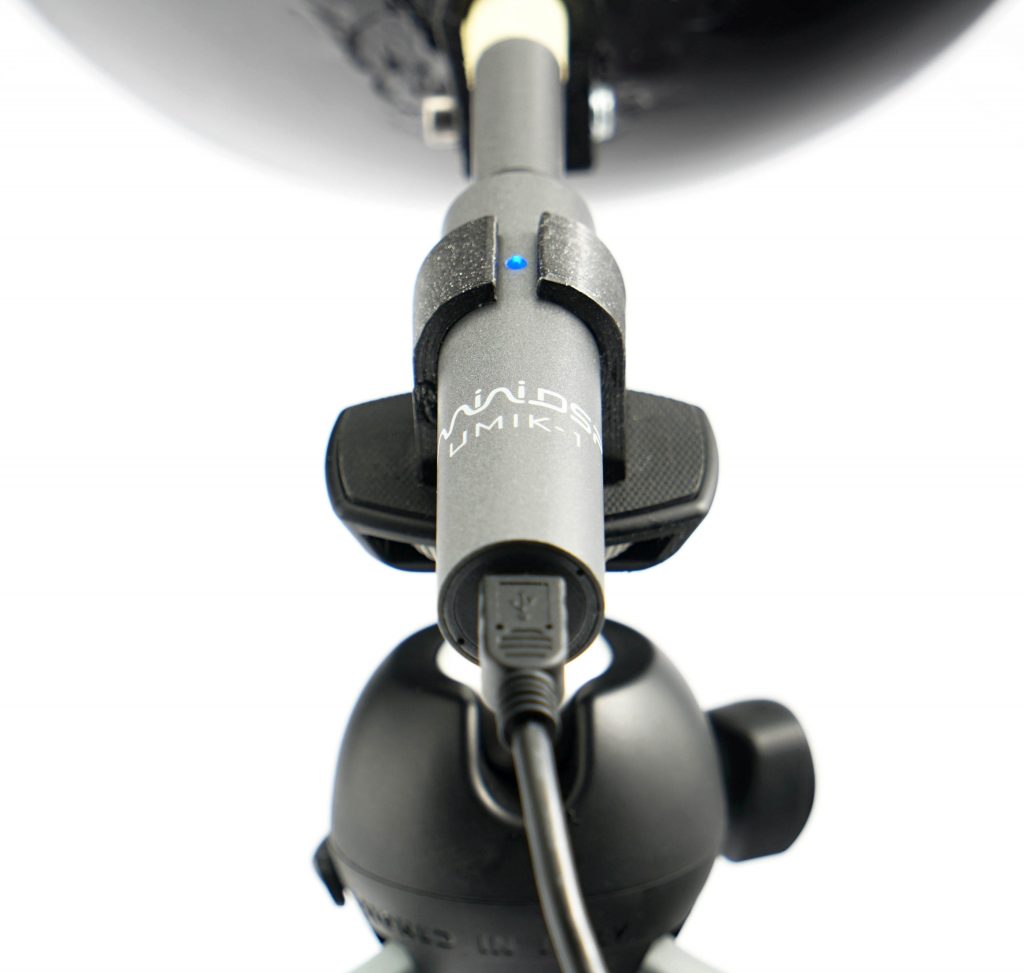
| Graphics card | Dominant sound freq. and noise level in F1 2020@2160p | NF-F12 PWM | NF-A15 PWM | ||||
| Low range | Mid range | High range | |||||
| Frequency [Hz] | Noise level [dBu] | Frequency [Hz] | Noise level [-dBu] | Frequency [Hz] | Noise level [-dBu] | ||
| AMD Radeon RX 6800 (SAM on) | 100,794 | -71,019 | 1076,347 | -66,494 | 9665,273 | -81,252 | |
| AMD Radeon RX 6800 (SAM off) | 100,794 | -71,759 | 1107,887 | -67,416 | 2091,412 | -75,288 | |
| Asus TUF RTX 3080 O10G Gaming | 100,794 | -76,045 | 1107,887 | -77,850 | 7034,643 | -74,423 | |
| AMD Radeon RX 6800 XT (SAM on) | 100,794 | -71,589 | 1107,887 | -74,742 | 10848,902 | -76,306 | |
| AMD Radeon RX 6800 XT (SAM off) | 100,794 | -72,991 | 1107,887 | -74,724 | 10848,902 | -76,519 |
| Graphics card | Dominant sound freq. and noise level in SOTTR@2160p | NF-F12 PWM | NF-A15 PWM | ||||
| Low range | Mid range | High range | |||||
| Frequency [Hz] | Noise level [dBu] | Frequency [Hz] | Noise level [-dBu] | Frequency [Hz] | Noise level [-dBu] | ||
| AMD Radeon RX 6800 (SAM on) | 100,794 | -71,769 | 1140,350 | -66,111 | 9948,487 | -81,293 | |
| AMD Radeon RX 6800 (SAM off) | 100,794 | -71,603 | 1140,350 | -67,765 | 9665,273 | -80,642 | |
| Asus TUF RTX 3080 O10G Gaming | 100,794 | -75,410 | 1076,347 | -72,321 | 7240,773 | -74,199 | |
| AMD Radeon RX 6800 XT (SAM on) | 100,794 | -73,222 | 1107,887 | -73,892 | 10848,902 | -76,328 | |
| AMD Radeon RX 6800 XT (SAM off) | 100,794 | -73,170 | 1107,887 | -75,262 | 10848,902 | -75,397 |
| Graphics card | Dominant sound freq. and noise level in Blender (Cycles), Classroom | NF-F12 PWM | NF-A15 PWM | ||||
| Low range | Mid range | High range | |||||
| Frequency [Hz] | Noise level [dBu] | Frequency [Hz] | Noise level [-dBu] | Frequency [Hz] | Noise level [-dBu] | ||
| AMD Radeon RX 6800 (SAM on) | 100,794 | -71,913 | 987,015 | -89,190 | 7452,944 | -88,332 | |
| AMD Radeon RX 6800 (SAM off) | 100,794 | -71,136 | 987,015 | -89,041 | 7452,944 | -88,237 | |
| Asus TUF RTX 3080 O10G Gaming | 106,787 | -81,541 | 1659,995 | -80,568 | 6834,380 | -77,967 | |
| AMD Radeon RX 6800 XT (SAM on) | 97,924 | -79,763 | 1208,159 | -89,625 | 7671,332 | -85,188 | |
| AMD Radeon RX 6800 XT (SAM off) | 100,794 | -72,980 | 1243,561 | -95,235 | 7671,332 | -84,980 |
| Graphics card | Dominant sound freq. and noise level in CS:GO@1080p (coils only) | NF-F12 PWM | NF-A15 PWM | ||||
| Low range | Mid range | High range | |||||
| Frequency [Hz] | Noise level [dBu] | Frequency [Hz] | Noise level [-dBu] | Frequency [Hz] | Noise level [-dBu] | ||
| AMD Radeon RX 6800 (SAM on) | 100,794 | -71,813 | 987,015 | -87,658 | 7452,944 | -80,420 | |
| AMD Radeon RX 6800 (SAM off) | 100,794 | -72,013 | 1659,955 | -90,354 | 8863,094 | -84,530 | |
| Asus TUF RTX 3080 O10G Gaming | 100,794 | -75,576 | 1140,350 | -81,739 | 9948,487 | -78,734 | |
| AMD Radeon RX 6800 XT (SAM on) | 100,794 | -73,593 | 1659,955 | -79,766 | 7452,944 | -73,997 | |
| AMD Radeon RX 6800 XT (SAM off) | 100,794 | -73,272 | 1659,955 | -83,327 | 7452,944 | -76,372 |
- Contents
- Methodology: performance tests
- Methodology: how we measure power draw
- Methodology: noise and sound measurement
- Methodology: heat tests
- Test rig
- 3DMark
- Age of Empires II: DE
- Assassin’s Creed: Valhalla
- Battlefield V
- Battlefield V with DXR
- Borderlands 3
- Control
- Control with DXR
- Counter-Strike: GO
- Cyberpunk 2077
- Cyberpunk 2077 with FidelityFX CAS
- DOOM Eternal
- F1 2020
- FIFA 21
- Forza Horizon 4
- Mafia: DE
- Metro Exodus
- Metro Exodus with DXR
- Microsoft Flight Simulator
- Red Dead Redemption 2 (Vulkan)
- Red Dead Redemption 2 (Dx12)
- Shadow of the Tomb Raider
- Shadow of the Tomb Raider with DXR
- Total War Saga: Troy
- Wasteland 3
- Overall game performance and performance per euro
- CompuBench (OpenCL)
- SPECviewperf 2020 and SPECworkstation 3
- FLOPS, IOPS and memory speed tests
- 3D rendering 1/2 (LuxMark and Blender@Cycles)
- 3D rendering 2/2 (Blender@Radeon ProRender and Eevee)
- Photo editing (Adobe Photoshop, Lightroom and Affinity Photo)
- Broadcasting (OBS and Xsplit)
- Password cracking
- GPU clock speed
- GPU heating
- Net graphics power draw and performance per watt
- Analysis of 12 V subcircuit power supply (higher load)
- Analysis of 12 V subcircuit power supply (lower load)
- Analysis of 3.3 V subcircuit power supply
- Noise level
- Frequency response of sound
- Conclusion





